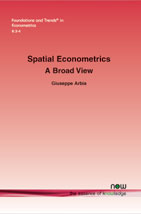Spatial Econometrics: A Broad View
By Giuseppe Arbia, Università Cattolica del Sacro Cuore, Rome, Italy, giuseppearbia13@gmail.com
Abstract
Spatial econometrics can be defined in a narrow and in a broader sense. In a narrow sense it refers to methods and techniques for the analysis of regression models using data observed within discrete portions of space such as countries or regions. In a broader sense it is inclusive of the models and theoretical instruments of spatial statistics and spatial data analysis to analyze various economic effects such as externalities, interactions, spatial concentration and many others. Indeed, the reference methodology for spatial econometrics lies on the advances in spatial statistics where it is customary to distinguish between different typologies of data that can be encountered in empirical cases and that require different modelling strategies. A first distinction is between continuous spatial data and data observed on a discrete space. Continuous spatial data are very common in many scientific disciplines (such as physics and environmental sciences), but are still not currently considered in the spatial econometrics literature. Discrete spatial data can take the form of points, lines and polygons. Point data refer to the position of the single economic agent observed at an individual level. Lines in space take the form of interactions between two spatial locations such as flows of goods, individuals and information. Finally data observed within polygons can take the form of predefined irregular portions of space, usually administrative partitions such as countries, regions or counties within one country.
In this monograph we will adopt a broader view of spatial econometrics and we will introduce some of the basic concepts and the fundamental distinctions needed to properly analyze economic datasets observed as points, regions or lines over space. It cannot be overlooked the fact that the mainstream spatial econometric literature was recently the subject for harsh and radical criticisms by a number of papers. The purpose of this monograph is to show that much of these criticisms are in fact well grounded, but that they lose relevance if we abandon the narrow paradigm of a discipline centered on the regression analysis of regional data, and we embrace the wider acceptation adopted here. In Section 2 we will introduce methods for the spatial econometric analysis of regional data that, so far, have been the workhorse of most theoretical and empirical work in the literature. We will consider modelling strategies falling within the general structure of the SARAR paradigm and its particularizations by presenting the various estimation and hypothesis testing procedures based on Maximum Likelihood (ML), Generalized Method of Moments (GMM) and Two-Stage Least Squares (2SLS), that were proposed in the literature to remove the ineffieciencies and inconsistencies arising from the presence of various forms of spatial dependence. Section 3 is devoted to the new emerging field of spatial econometric analysis of individual granular spatial data sometimes referred to as spatial microeconometrics. We present modelling strategies that use information about the actual position of each economic agent to explain both individuals' location decisions and the economic actions observed in the chosen locations. We will discuss the peculiarities of general spatial autoregressive model in this setting and the use of models where distances are used as predictors in a regression framework. We will also present some point pattern methods to model individuals' locational choices, as well as phenomena of co-localization and joint-localization. Finally in Section 4 the general SARAR paradigm is applied to the case of spatial interaction models estimated using data in the form of origin–destination variables and specified following models based on the analogy with the Newtonian law of universal gravitation. The discussion in this monograph is intentionally limited to the analysis of spatial data observed in a single moment of time leaving out of presentation the case of dynamic spatial data such as those observed in spatial panel data.
Spatial Econometrics: A Broad View
Spatial Econometrics takes a broader view of spatial econometrics and introduces some of the basic concepts. After an introduction, Section 2 introduces methods for the spatial econometric analysis of regional data that have been the focus of most theoretical and empirical work in this literature. This section considers modelling strategies falling within the general structure of the SARAR paradigm and of its particularizations by presenting the various estimation and hypothesis testing procedures based on Maximum Likelihood (ML), Generalized Method of Moments (GMM) and Two Stage Least Squares (2SLS). Section 3 is devoted to the new emerging field of spatial econometric analysis of individual granular spatial data sometimes referred to as spatial microeconometrics. The author presents modelling strategies that use information about the actual position of each economic agent to explain both individuals' location decisions and the economic actions observed in the chosen locations. This section reviews the peculiarities of general spatial autoregressive model in this setting and the use of models where distances are used as predictors in a regression framework, as well as presenting some point pattern methods to model individuals' locational choices, and the phenomena of co-localization and joint-localization. Finally, Section 4 applies the general SARAR paradigm to the case of spatial interaction models estimated using data in the form of origin-destination variables and specified following models based on the analogy with the Newtonian law of universal gravitation. The discussion is intentionally limited to the analysis of spatial data observed in a single moment of time leaving out of the presentation the case of dynamic spatial data such as those observed in spatial panel data.
